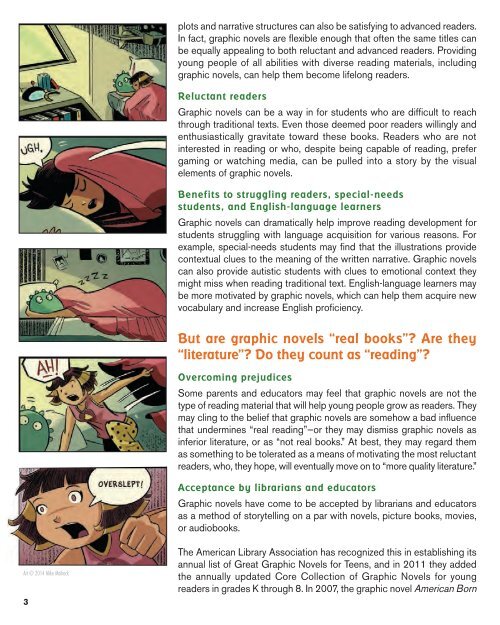guide_to_using_graphic_novels_new_2015_0
guide_to_using_graphic_novels_new_2015_0
guide_to_using_graphic_novels_new_2015_0
You also want an ePaper? Increase the reach of your titles
YUMPU automatically turns print PDFs into web optimized ePapers that Google loves.
plots and narrative structures can also be satisfying <strong>to</strong> advanced readers.<br />
In fact, <strong>graphic</strong> <strong>novels</strong> are flexible enough that often the same titles can<br />
be equally appealing <strong>to</strong> both reluctant and advanced readers. Providing<br />
young people of all abilities with diverse reading materials, including<br />
<strong>graphic</strong> <strong>novels</strong>, can help them become lifelong readers.<br />
Reluctant readers<br />
Graphic <strong>novels</strong> can be a way in for students who are difficult <strong>to</strong> reach<br />
through traditional texts. Even those deemed poor readers willingly and<br />
enthusiastically gravitate <strong>to</strong>ward these books. Readers who are not<br />
interested in reading or who, despite being capable of reading, prefer<br />
gaming or watching media, can be pulled in<strong>to</strong> a s<strong>to</strong>ry by the visual<br />
elements of <strong>graphic</strong> <strong>novels</strong>.<br />
Benefits <strong>to</strong> struggling readers, special-needs<br />
students, and English-language learners<br />
Graphic <strong>novels</strong> can dramatically help improve reading development for<br />
students struggling with language acquisition for various reasons. For<br />
example, special-needs students may find that the illustrations provide<br />
contextual clues <strong>to</strong> the meaning of the written narrative. Graphic <strong>novels</strong><br />
can also provide autistic students with clues <strong>to</strong> emotional context they<br />
might miss when reading traditional text. English-language learners may<br />
be more motivated by <strong>graphic</strong> <strong>novels</strong>, which can help them acquire <strong>new</strong><br />
vocabulary and increase English proficiency.<br />
But are <strong>graphic</strong> <strong>novels</strong> “real books”? Are they<br />
“literature”? Do they count as “reading”?<br />
Overcoming prejudices<br />
Some parents and educa<strong>to</strong>rs may feel that <strong>graphic</strong> <strong>novels</strong> are not the<br />
type of reading material that will help young people grow as readers. They<br />
may cling <strong>to</strong> the belief that <strong>graphic</strong> <strong>novels</strong> are somehow a bad influence<br />
that undermines “real reading”—or they may dismiss <strong>graphic</strong> <strong>novels</strong> as<br />
inferior literature, or as “not real books.” At best, they may regard them<br />
as something <strong>to</strong> be <strong>to</strong>lerated as a means of motivating the most reluctant<br />
readers, who, they hope, will eventually move on <strong>to</strong> “more quality literature.”<br />
Acceptance by librarians and educa<strong>to</strong>rs<br />
Graphic <strong>novels</strong> have come <strong>to</strong> be accepted by librarians and educa<strong>to</strong>rs<br />
as a method of s<strong>to</strong>rytelling on a par with <strong>novels</strong>, picture books, movies,<br />
or audiobooks.<br />
Art © 2014 Mike Maihack<br />
3<br />
The American Library Association has recognized this in establishing its<br />
annual list of Great Graphic Novels for Teens, and in 2011 they added<br />
the annually updated Core Collection of Graphic Novels for young<br />
readers in grades K through 8. In 2007, the <strong>graphic</strong> novel American Born


